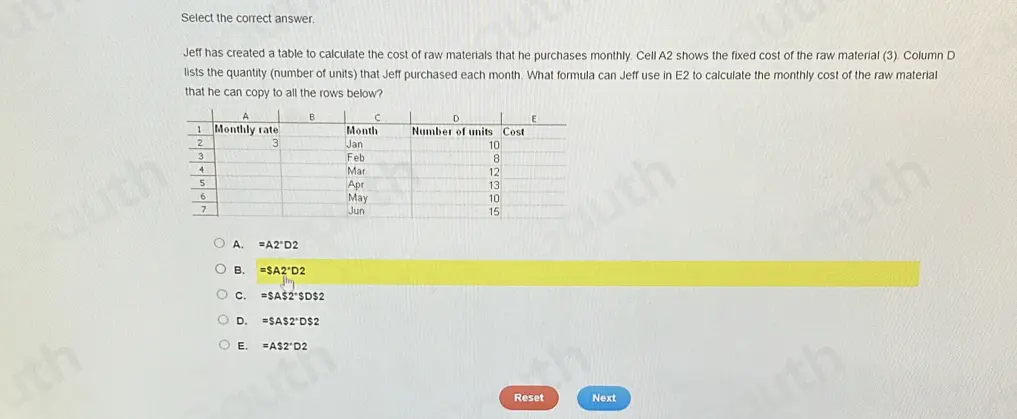Homework Help: Questions and Answers: Select the correct answer. Jeff has created a table to calculate the cost of raw materials that he purchases monthly. Cell A2 shows the fixed cost of the raw material (3). Column D lists the quantity (number of units) that Jeff purchased each month. What formula can Jeff use in E2 to calculate the monthly cost of the raw material that he can copy to all the rows below?

| A | B | C | D | E | |
|---|---|---|---|---|---|
| 1 | Monthly Rate | Month | Number of Units | Cost | |
| 2 | 3 | Jan | 10 | ||
| 3 | Feb | 8 | |||
| 4 | Mar | 12 | |||
| 5 | Apr | 13 | |||
| 6 | May | 10 | |||
| 7 | Jun | 15 |
A. =A2*D2
B. =$A2*D2
C. =$A$2*$D$2
D. =$A$2*D$2
E. = A$2*D2
Answer:
First, let’s understand the question:
- Jeff’s goal is to calculate the monthly cost of raw materials.
- The fixed cost per unit is listed in cell
A2(which is 3). - The number of units purchased each month is listed in column D (cells D3 to D7).
- The monthly cost of raw material should be calculated in column E (cells E3 to E7).
Now, we need to determine the formula that Jeff can use in E2, which he can then copy down for all rows to calculate the monthly cost of raw material.
Step-by-Step Answering:
- Fixed cost per unit is located in cell
A2, and this value needs to be multiplied by the number of units for each month. - The number of units for each month is in column D (D3 for January, D4 for February, etc.).
- The cost calculation should be done for each month by multiplying the fixed cost (A2) by the number of units in column D.
Formula Explanation:
A2is a mixed reference where column A is locked (because of the$), but the row can change when copied.D2is a relative reference, meaning both the column and row can change when copied down.
So, when copying this formula down:
- $A2 will always refer to column A, but the row number will change (e.g., $A3, $A4, etc.).
- D2 will change to D3, D4, etc., as the formula is copied down.
In this case, option B ($A2*D2) works because we don’t need to lock row 2 for the fixed cost; column A will stay the same while the row changes.
Final Answer:
Based on the above analysis, the correct answer is:
B) $A2 * D2
This formula will calculate the monthly cost by multiplying the fixed cost in cell A2 by the quantity purchased in the corresponding row in column D. When you copy this formula down, the reference to D2 will adjust to the appropriate row, while the reference to A2 will remain fixed.
Learn More: Homework Help
Q. Why were magnetic tapes used to replace punch cards in Second Generation computers?
Q. Which answer choice does NOT describe a responsibility of a safe social media user?
Q. What is the difference between a single platform and a dynamic adaptive platform?
Q. A user generates an image, then asks the model to make further modifications to the same image.